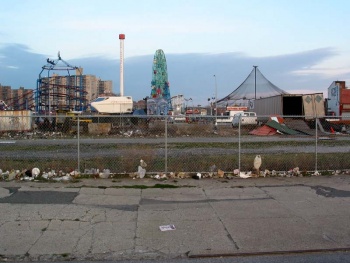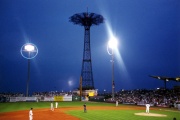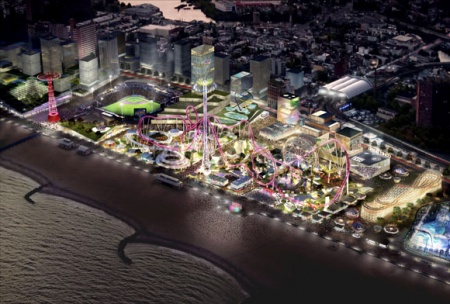Coney Island DestinationsFrom The Peopling of New York CityThe End of the Line
Lasting Effects of Public HousingBy the new millennium, the development of the new housing units tapered off. What was left of Coney Island wasn't much. Tall brick buildings were now embedded into the skyline, and the former amusement area was now perhaps ninety-percent residential. A lot of land was left deserted and in ruins. Former buildings and restaurants that once crawled with people were now all boarded up and decorated by graffiti. Crime rates have continued to be high, and the presence of drugs and prostitution in Coney are still prevalent. According to statistics from Prudential Douglas Elliman Real Estates, Coney Island is home to murder rates that are 30% more than the national average with rape charges close behind at 0.88 (1.0 being the national average). The most shocking statistic would be the amount of robbery in Coney Island - standing at a whopping 3.09, which measures three times as high as any city across the nation.[1] These numbers help to justify the poverty levels in the area - that people have to resort to stealing from one another to get by. Either that, or Coney Island residents are just plagued with the kleptomaniac gene. The decline of the amusement areas continued as well. The year 2000 saw the destruction of the Thunderbolt Roller Coaster, which had been a undeclared landmark of Coney Island for quite some time. Over the years, the only remaining amusement park, Astroland, suffered a great deal of loss in visitors. It no longer attracted people like it used to. Coney Island was no longer the place that came to anyone's mind when you say the words "amusement park." Several of the high-rise apartment complexes built between the 50s and 70s still stand tall today. The Trump Village development, Peter Warbasse's housing project, Luna Park Houses, as well as many of the projects alongside Surf Avenue still remain today, housing many of Coney Island's long time residents. Through the first couple of years of the 2000s, revitalization efforts in Coney Island were once again brought to surface of Brooklyn officials' minds. The construction of Keyspan Park was an attempt to bring visitors back to the impoverished area. Though Coney had suffered a loss when the Brooklyn Dodger left, the 2000s saw the fresh faces of the Brooklyn Cyclones. The Brooklyn Chamber of Commerce devoted their time and effort to bring back the livelihood that Coney Island once stood for. All they wanted to do was to preserve "Brooklyn's historic playground."[2] The goal was to stop the decline in its tracks and perhaps one day, restore Coney Island to the greatness it once was.
Future Plans
The decline of Coney Island over the years has brought about the closure of Astroland, the last amusement park still existing in Coney Island. The park will remain open for one more summer before it is scheduled to go under the knife and undergo a "renaissance." The new development plans for the now dull and dangerous neighborhood will look to bring back the glitz and glamour Coney once held. Back in November 2007, City Planning Officials, along with the New York City Economic Development Corporation, the Brooklyn Chamber of Commerce, Mayor Michael Bloomberg, and the Coney Island Development Corporation came out with their anticipated plans to revitalize the Coney Island area. It will encompass a little of everything: amusement area, housing, and commerical area for retail uses. As NYCEDC President Lieber stated in the press release: "By recapturing the dynamism of Coney Island's historic past, we will help create an enviable place to live, a great place to play and provide new economic opportunities for this area of Brooklyn and for the city."[3] The goal of the new development plans would be to construct 4,000 to 5,000 new housing units, and dedicate approximately 500,000 square feet of land around the area towards new retail usage. Though the cost of development plan is not listed on the press release, it is safe to assume that beauty does not come cheaply. As the digital sketch provided by City Planning shows, bright lights are to light up the amusement areas, further contributing to the light pollution from which New York City suffers from. The intention of which would to bring back the nightlife that Coney has lost. The current dangerousness of the neighborhood only invites those to dare risk their lives to wander outside under the dark, night sky. The developer in charge of this project, Thor Equities led by Joe Sitt, has planned for some new rides for the new amusement park. Three of the rides outlined in Wills' article include the Leviathan, the Aviator, and a new "three-tiered carousel." The Leviathan will be a new roller coaster installment that is supposed to raise the bar for thrill seekers, as it is supposed to dip below the boardwalk level. The Aviator is going to be an attraction with "high-flying cars, individually controlled by joystick."[4] The new development would not be new in all aspects. The plans intend to keep some of the great iconic landmarks that Coney Island has become associated with hand in hand. These include the Parachute Jump, the Cyclone Roller Coaster, the Famous Nathan's Hot Dog Restaurant, and the Boardwalk. The officials do not plan on ridding old memories for new ones, but instead, to build on old memories and bring back the culture and oddities that Coney once held.[5] Coney Island seems to be the perfect site for this new redevelopment plan. In the CIDC presentation, some of the greatest sites mentioned contain elements that Coney already has and can easily acquire. The lights and entertainment of New York's Times Square; the urban lifestyle; the intergenerational and cultural presence; waterfront properties like beaches in Venice and Santa Monica. City officials want to build a recreational area that is fun for everyone and will be open year round to accommodate everyone. They estimate that within 30 years time, the new Coney Island should be able to generate about $6.5 billion in tax revenue.[6]
References
|



